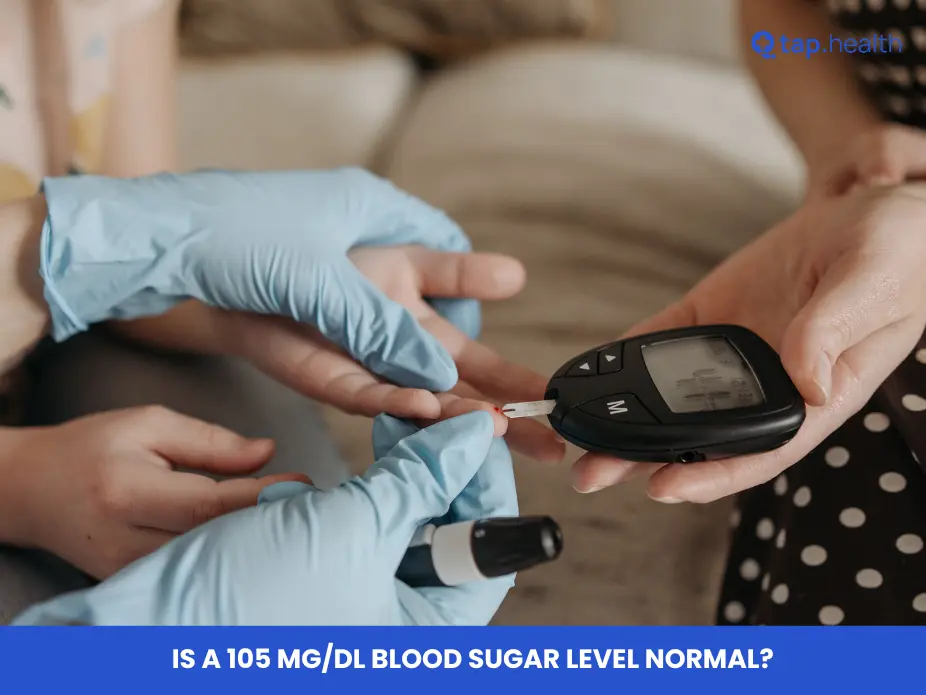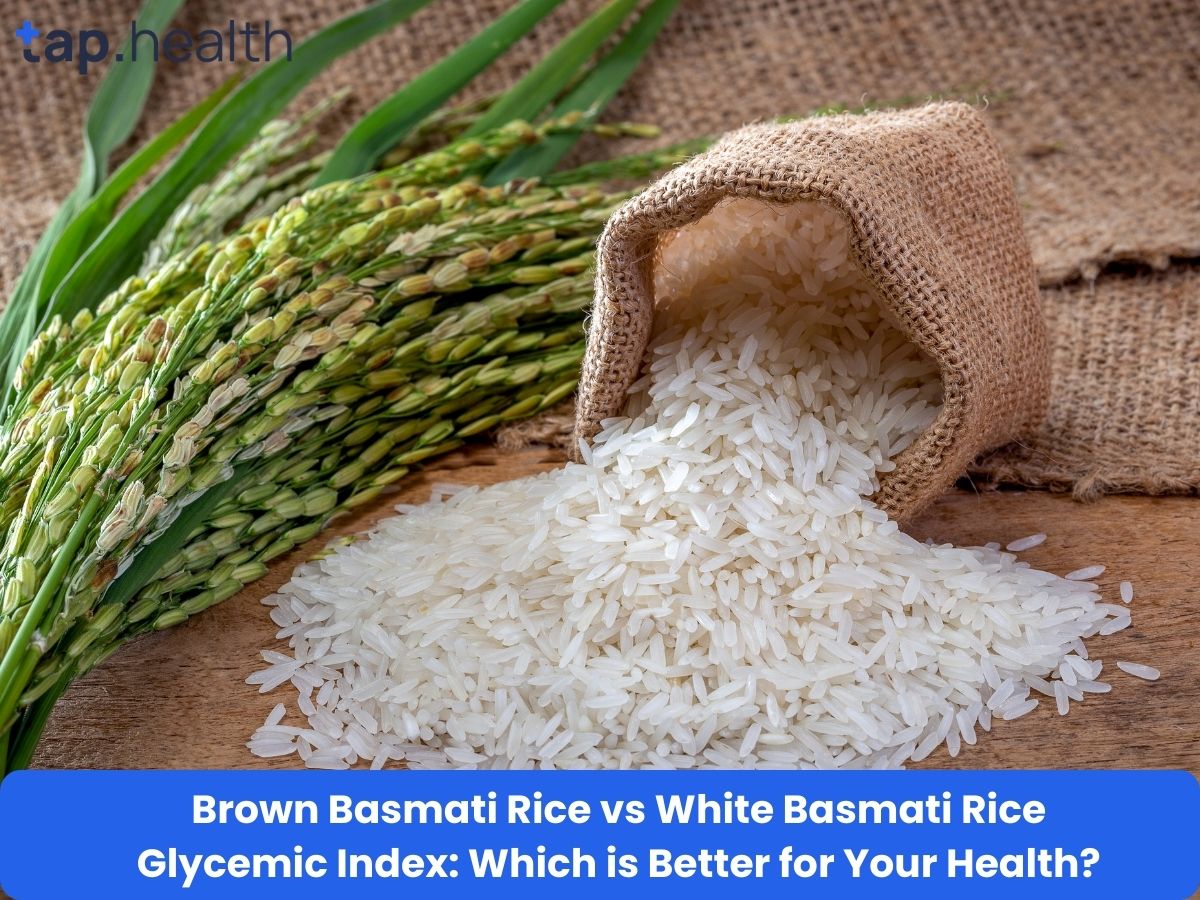Maintaining stable blood sugar is essential for overall health, as fluctuating glucose levels can lead to various health problems, including diabetes. Many people are concerned about their blood sugar levels and wonder, “Is a 105 mg/dL blood sugar level normal?” Understanding what this number means and what actions to take is crucial for long-term health.
In this blog, we will explore in-depth whether a 105 mg/dL blood sugar level is considered normal or an indication of a health concern. By the end, you’ll have a better understanding of how blood sugar works, what different blood sugar readings signify, and what you can do to keep your glucose levels in check.
What is Blood Sugar?
Blood sugar, or blood glucose, is the amount of glucose present in the blood. It is the primary source of energy for your body’s cells and comes from the carbohydrates you consume in your diet. Insulin, a hormone produced by the pancreas, plays a key role in regulating blood sugar by allowing cells to absorb glucose for energy.
Having balanced blood sugar levels is important for your health because high or low glucose levels can have serious consequences, including diabetes, cardiovascular disease, and nerve damage.
Is a 105 mg/dL Blood Sugar Level Normal?
A 105 mg/dL blood sugar level is considered impaired fasting glucose (IFG), which is a form of prediabetes. While not dangerously high, this level signals that your blood sugar is higher than normal, which places you at an increased risk of developing type 2 diabetes.
A normal fasting blood sugar level is typically between 70 and 99 mg/dL, meaning that a reading of 105 mg/dL is slightly above the normal range, but not high enough to be classified as diabetes (which is diagnosed with a fasting blood sugar level of 126 mg/dL or higher).
Prediabetes: A Warning Sign
Prediabetes is a condition where blood sugar levels are elevated, but not yet high enough to be diagnosed as diabetes. If you have prediabetes, you are at risk for developing type 2 diabetes, heart disease, and stroke. However, it is possible to reverse prediabetes and lower blood sugar levels through lifestyle changes, such as diet and exercise.
The Importance of Monitoring Your Blood Sugar
A 105 mg/dL reading indicates that you should take proactive steps to lower your blood sugar and prevent the progression to type 2 diabetes. Regular monitoring of your blood sugar and early interventions can reduce the risk of developing more serious health issues.
Blood Sugar Levels Explained
Understanding the classification of blood sugar levels can help you gauge whether your current readings fall within the normal range, or if they indicate a potential health issue.
Here are the key categories for blood sugar levels:
- Normal Fasting Blood Sugar: 70–99 mg/dL
- This is the healthy range, indicating that your body is properly regulating blood glucose.
- Impaired Fasting Glucose (IFG): 100–125 mg/dL
- This range is considered prediabetes, and it means that you are at risk of developing type 2 diabetes if lifestyle changes aren’t made.
- Diabetes: 126 mg/dL or higher
- This is the range for diabetes, and it is diagnosed when blood sugar levels remain consistently high. At this point, medical intervention and management are necessary to prevent complications.
Postprandial Blood Sugar Levels (After Eating)
Postprandial blood sugar levels refer to the glucose level in the blood two hours after eating. For a normal individual, these levels should generally be less than 140 mg/dL.
If your postprandial blood sugar level is above 140 mg/dL, it may indicate that your body is not effectively managing glucose, even if your fasting blood sugar is in the normal range. This can also be an indicator of prediabetes or diabetes.
When Is a 105 mg/dL Blood Sugar Level a Concern?
A fasting blood sugar level of 105 mg/dL falls into the prediabetes category, meaning it is above the normal range. While it is not immediately dangerous, it is important to treat it as a warning sign. If your blood sugar levels stay elevated in the prediabetes range, you may eventually develop type 2 diabetes.
What Does This Mean for Your Health?
- Increased Risk of Type 2 Diabetes: Individuals with prediabetes are five to ten times more likely to develop type 2 diabetes. This condition occurs when the body becomes resistant to insulin, causing glucose to build up in the bloodstream.
- Heart Disease and Stroke Risk: High blood sugar can damage blood vessels and increase the risk of heart disease and stroke. Maintaining healthy blood sugar levels is important for preventing cardiovascular problems.
- Other Complications: Elevated blood sugar can also increase the risk of kidney damage, nerve damage (neuropathy), and eye damage (retinopathy), especially if left unchecked over time.
Taking Action Now
The good news is that prediabetes can be reversed. By making lifestyle changes like improving your diet, increasing physical activity, and losing weight, you can lower your blood sugar and prevent the onset of type 2 diabetes.
Factors Affecting Blood Sugar Levels
Several factors influence your blood sugar levels, making it essential to understand the variables that can cause fluctuations in glucose readings.
1. Diet
The foods you eat directly impact your blood sugar. Foods high in carbohydrates and sugars cause quick spikes in glucose levels. On the other hand, foods rich in fiber and protein help slow down the absorption of glucose, resulting in more stable blood sugar levels.
2. Physical Activity
Exercise helps improve insulin sensitivity, which means your body can use glucose more efficiently. Engaging in regular physical activity, including both aerobic exercises (like walking or cycling) and strength training, can help regulate blood sugar.
3. Stress
Chronic stress triggers the release of stress hormones like cortisol, which can raise blood sugar by stimulating the liver to release glucose into the bloodstream. Managing stress through techniques like meditation, deep breathing, or yoga can help prevent blood sugar spikes.
4. Medications
Certain medications, such as steroids and diuretics, can raise blood sugar levels, while others, like metformin or insulin, help lower blood sugar. Always consult your healthcare provider if you are concerned about how your medications might affect your blood sugar.
5. Sleep
Sleep deprivation or poor-quality sleep can interfere with the body’s ability to regulate insulin, potentially leading to higher blood sugar levels. Aim for 7-9 hours of quality sleep each night to support healthy blood sugar regulation.
How to Maintain Healthy Blood Sugar Levels
If your blood sugar is around 105 mg/dL, it’s crucial to adopt healthy habits to avoid developing diabetes and other related health issues. Here are some strategies to help you manage and maintain healthy blood sugar levels:
1. Balanced Diet
A healthy, balanced diet is essential for managing blood sugar levels. Focus on:
- Whole grains like quinoa, oats, and brown rice.
- Non-starchy vegetables like spinach, broccoli, and peppers.
- Lean proteins such as chicken, fish, tofu, and legumes.
- Healthy fats from sources like olive oil, avocados, and nuts.
Limit processed foods, sugary snacks, and sugary drinks that can cause blood sugar spikes.
2. Regular Exercise
Exercise helps improve insulin sensitivity and lowers blood sugar levels. Try to engage in at least 150 minutes of moderate-intensity aerobic activity (e.g., brisk walking or cycling) each week. Additionally, incorporating strength training into your routine helps build muscle, which improves your body’s ability to use glucose effectively.
3. Weight Management
Maintaining a healthy weight can significantly improve your blood sugar levels and reduce the risk of developing type 2 diabetes. Even losing a small percentage of body weight (about 5-10%) can improve blood sugar regulation.
4. Stress Management
Practice stress-reducing techniques like mindfulness meditation, yoga, and deep breathing exercises to help keep your cortisol levels in check and prevent blood sugar fluctuations.
5. Regular Monitoring
If you’re concerned about your blood sugar levels, regularly checking your blood glucose using a glucose meter or a continuous glucose monitor (CGM) can help you track how your lifestyle affects your glucose levels.
Diet and Nutrition Tips
Your diet plays a major role in regulating blood sugar. Here are some dietary tips to help manage blood sugar:
- Choose low-GI foods: Foods with a low glycemic index (GI) release glucose slowly into the bloodstream. Examples include whole grains, non-starchy vegetables, and legumes.
- Eat fiber-rich foods: High-fiber foods like vegetables, fruits, and beans slow down glucose absorption and help stabilize blood sugar levels.
- Include healthy fats: Healthy fats from sources like avocados, olive oil, and nuts help to slow glucose absorption and improve insulin sensitivity.
- Avoid sugary snacks and beverages: Limit foods and drinks high in refined sugars, which cause rapid spikes in blood sugar levels.
Exercise and Lifestyle Tips
Incorporating regular physical activity into your routine is one of the best ways to manage blood sugar. Here are some tips:
- Exercise regularly: Aim for 150 minutes of moderate exercise per week.
- Strength training: Include strength training exercises to build muscle mass and improve glucose utilization.
- Be active throughout the day: Take breaks from sitting, walk after meals, and aim to incorporate more movement into your daily life.
When to Seek Medical Advice
If your blood sugar consistently measures 105 mg/dL or higher, it is important to consult with a healthcare provider. They may recommend additional testing, such as an A1c test (which measures average blood sugar over the past 2-3 months) or an oral glucose tolerance test (OGTT), to evaluate your risk for diabetes. Early detection and intervention are essential for preventing diabetes-related complications.
Real-Life Scenario
Imagine going for a routine health check-up, and your fasting blood sugar comes back as 105 mg/dL. It may not be alarming, but it’s a signal to watch your diet, exercise, and lifestyle. With small changes like daily walking, reducing sugary foods, and maintaining a healthy weight, you can often prevent blood sugar from rising further.
Expert Contribution
Endocrinologists explain that a slightly elevated blood sugar is an early warning sign. Consistently high readings can damage blood vessels and organs over time. Experts recommend regular monitoring and lifestyle modifications before medication is needed.
Recommendations Grounded in Proven Research and Facts
- Monitor your blood sugar regularly to track trends.
- Adopt a balanced diet rich in vegetables, whole grains, and lean proteins; reduce refined carbs and sugary drinks.
- Exercise regularly: Even 30 minutes of brisk walking daily can help control blood sugar.
- Maintain healthy weight: Excess body fat can increase insulin resistance.
- Consult a healthcare professional if fasting sugar frequently exceeds 100 mg/dL or if you have other risk factors like family history of diabetes.
Frequently Asked Questions (FAQs) on Is a 105 mg/dL blood sugar level dangerous?
1. Is a 105 mg/dL blood sugar level dangerous?
No, a 105 mg/dL blood sugar level is not immediately dangerous but indicates prediabetes, which means you are at risk for developing type 2 diabetes.
2. What should I do if my blood sugar is 105 mg/dL?
If your blood sugar is consistently at 105 mg/dL, you should focus on lifestyle changes like eating a healthy diet, exercising regularly, losing weight, and managing stress. You should also consult your healthcare provider.
3. How can I lower my blood sugar from 105 mg/dL?
You can lower your blood sugar by adopting a balanced diet, increasing physical activity, losing weight if necessary, and regularly monitoring your blood sugar levels.
4. What are the symptoms of elevated blood sugar?
Symptoms of elevated blood sugar may include increased thirst, frequent urination, blurred vision, fatigue, and slow-healing wounds. If you experience these symptoms, consult a healthcare provider.
Conclusion
A 105 mg/dL blood sugar level is considered prediabetes, and while not immediately harmful, it signals a need for lifestyle adjustments. By eating a balanced diet, exercising regularly, managing stress, and monitoring your blood sugar, you can lower your risk of progressing to type 2 diabetes and improve your overall health.
Early intervention is key to managing blood sugar levels and preventing the development of diabetes. Don’t wait to make the necessary changes—start today for a healthier future.
References
- Mayo Clinic. (2023). Prediabetes: Overview. Retrieved from https://www.mayoclinic.org/diseases-conditions/prediabetes/symptoms-causes/syc-20355278
- Centers for Disease Control and Prevention (CDC). (2023). Prediabetes. Retrieved from https://www.cdc.gov/diabetes/prevention/about-prediabetes.html
- Harvard Health Publishing. (2023). Managing Blood Sugar. Retrieved from https://www.health.harvard.edu/diabetes/managing-blood-sugar



